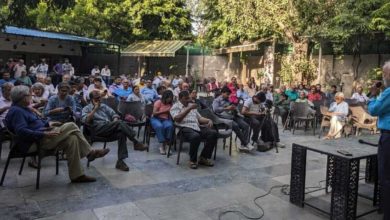The rightwing’s hopes for an overwhelming election wave that would hand them sizable majorities in Congress and control of a greatly expanded number of governorships failed to materialize. Votes in some parts of the country are still being counted, and other important data is still emerging, but at this stage at least one conclusion can be drawn: There is a large and determined current in society that wants to stand against the far right.
In Pennsylvania, extreme right-wing gubernatorial candidate Doug Mastriano was trounced 56 to 42 by his Democratic opponent in a state that Biden won in 2020 by just a single percentage point. In Georgia, long-dominated by Republicans, Senator Raphael Warnock has the edge going into a second round against Trump-backed candidate Herschel Walker. Walker’s performance lagged behind the first-round 8-point victory by Republican candidate for governor Brian Kemp — certainly a right-winger but one who has a public profile as being an opponent of Trump and the far right. A similar discrepancy can be found in Ohio, where far-right Trump ally J.D. Vance is up by a 6-point margin in the Senate race — far less impressive than the 26-point blowout won by Republican Governor Mike DeWine. Far-right Army general Don Bolduc was easily beaten 54 to 45 by vulnerable Democrat Maggie Hassan in New Hampshire.
The Republicans are on course for only a very narrow, perhaps single-digit majority in the House of Representatives. This is far from the convincing “governing majority” the Republican leadership expected and despite the advantage they received from newly-gerrymandered districts that made some of their wins all but inevitable. Racist ad campaigns fearmongering about “crime” appear to have not had the desired effect.
But the clearest sign of millions of people’s desire to stand up to the far right came in the five abortion-related referendums on the ballot throughout the country. In Kentucky and Montana, considered by ruling-class pundits to be “red states” inevitably dominated by reactionaries, voters rejected right-wing anti-abortion initiatives. Three states overwhelmingly approved constitutional amendments to guarantee abortion rights: Michigan by a 14-point margin, California by 30 percentage points and Vermont by 54.
Other ballot measures are also sources of hope. In Illinois, about 59 percent of voters supported a referendum to amend the state constitution to prohibit the introduction of anti-union “right to work” laws. In Massachusetts, voters approved a measure to impose a new tax on millionaires. A vote to expand Medicaid access in South Dakota won convincingly with 56 percent support.
These victories were made possible not only by the tens of millions of people who voted on election day, but also the huge numbers of people who organized and volunteered on campaigns that defeated the lavishly-funded right-wing forces. They are an example of the type of grassroots, sustained fight back we need nationwide.
The election results are a major blow to the political standing of Donald Trump, who used the election as a vehicle to get attention for himself and take revenge on his opponents within the Republican Party. In a piece titled, “Trump Is the Republican Party’s Biggest Loser,” the editorial board of the Wall Street Journal — the premiere voice of the right-wing ruling class establishment — argued, “Mr. Trump has botched the 2022 elections, and it could hand Democrats the Senate for two more years. Mr. Trump had policy successes as President, including tax cuts and deregulation, but he has led Republicans into one political fiasco after another.” Ron DeSantis is emerging as a potential alternative leading figure for the far right and the Republican Party as a whole.
While Republicans were left disappointed and Democrats breathed a sigh of relief, in a sense it is remarkable that the Democratic Party was not able to perform even better considering how unpopular the politics of the rightwing are. Beholden to Wall Street and Corporate America, the Democrats were unwilling to articulate a narrative of their own on the economy, ceding this crucial ground to Republicans instead of putting forward a pro-worker plan to tackle inflation and expose that it is corporate greed — not social programs to sustain workers — causing prices to skyrocket. The Democrats had hardly anything at all to say about the economy, having refused to fight for the progressive aspects of their own program over the last two years like the American Families Plan. If the Democratic Party had pushed through the Build Back Better social program expansion instead of capitulating to a small internal right flank, this would have greatly improved their popularity. They secured short-term victories through their promotion of several “more beatable” far-right candidates in Republican primaries, but this maneuver still gave those candidates a massive public platform during the campaign and an opportunity to shape public consciousness.
That Republicans underperformed in the face of such a pitiful opponent is testament to how repulsive their politics are to a broad section of society.
The complexity and highly varied nature of the U.S. electoral system also needs to be taken into account. This skews the results in a way that makes the population seem less progressive than it actually is. The Senate itself is an example of this. People in California and in Idaho both went to the polls to elect senators on Tuesday. Idaho has a population of 1.9 million and California has a population of 39.2 million — and yet both states are evenly represented with two seats. In the House of Representatives, congressional districts are drawn in such a totally rigged way that the outcome in the vast majority are never in doubt and the right wing has a built-in advantage in the bulk of them. Such a tiny sliver of the population votes in a jurisdiction that really matters to the outcome of the election.
The rigging of congressional district maps often has a profoundly racist character. Black, Latino and other oppressed communities are concentrated in some districts and diluted in others to minimize their representation. This is on top of racist voter suppression — both longstanding forms and newer measures implemented as part of the wave of legislation passed in recent years by right-wing dominated state governments.
The huge number of people who reject the far right can also be mobilized to fight for the end of this oppressive, irrational and undemocratic system. Elections will be benchmarks as this struggle unfolds, but the fight will be won by millions of people in the streets determined to defend democratic rights and build a whole new kind of society.






